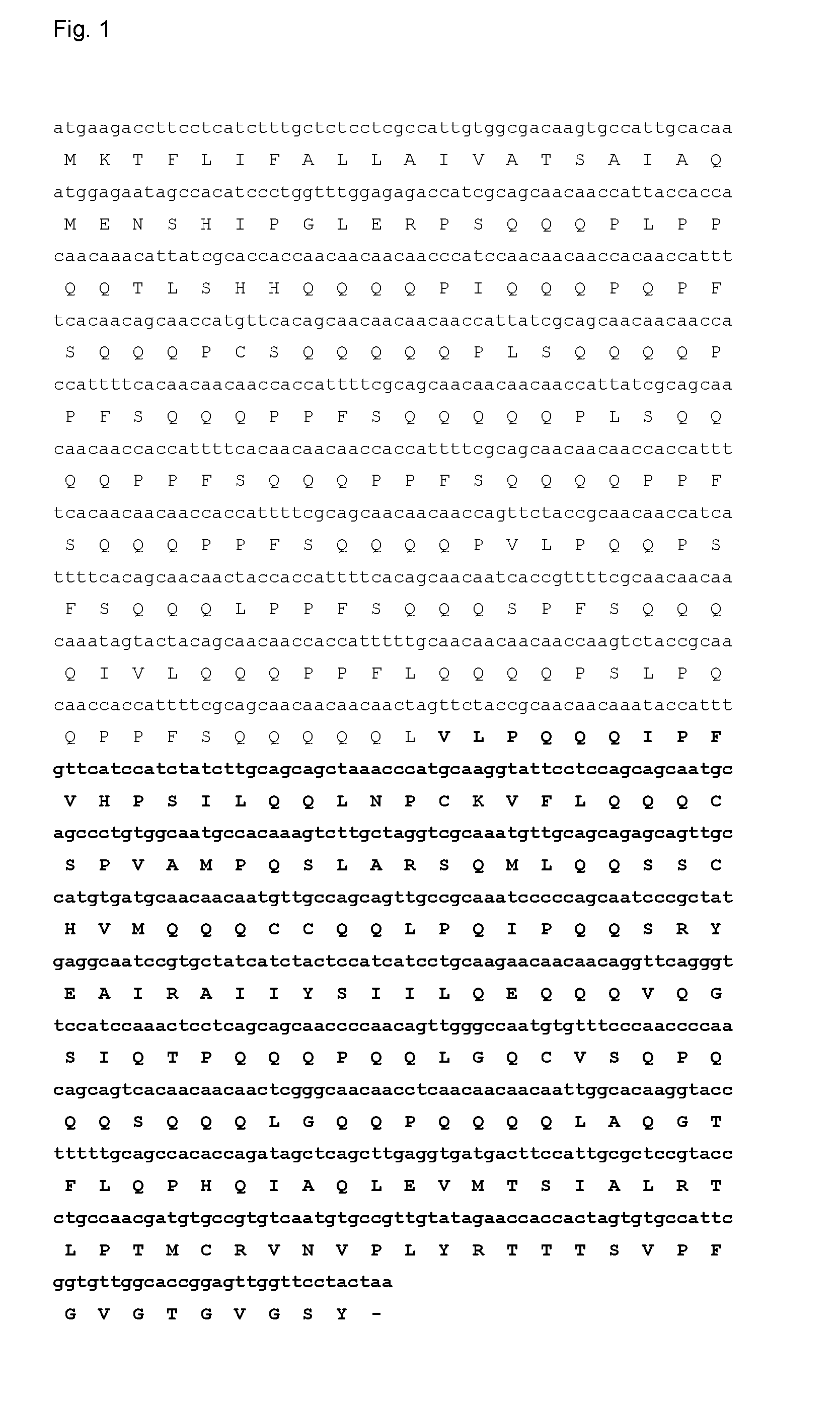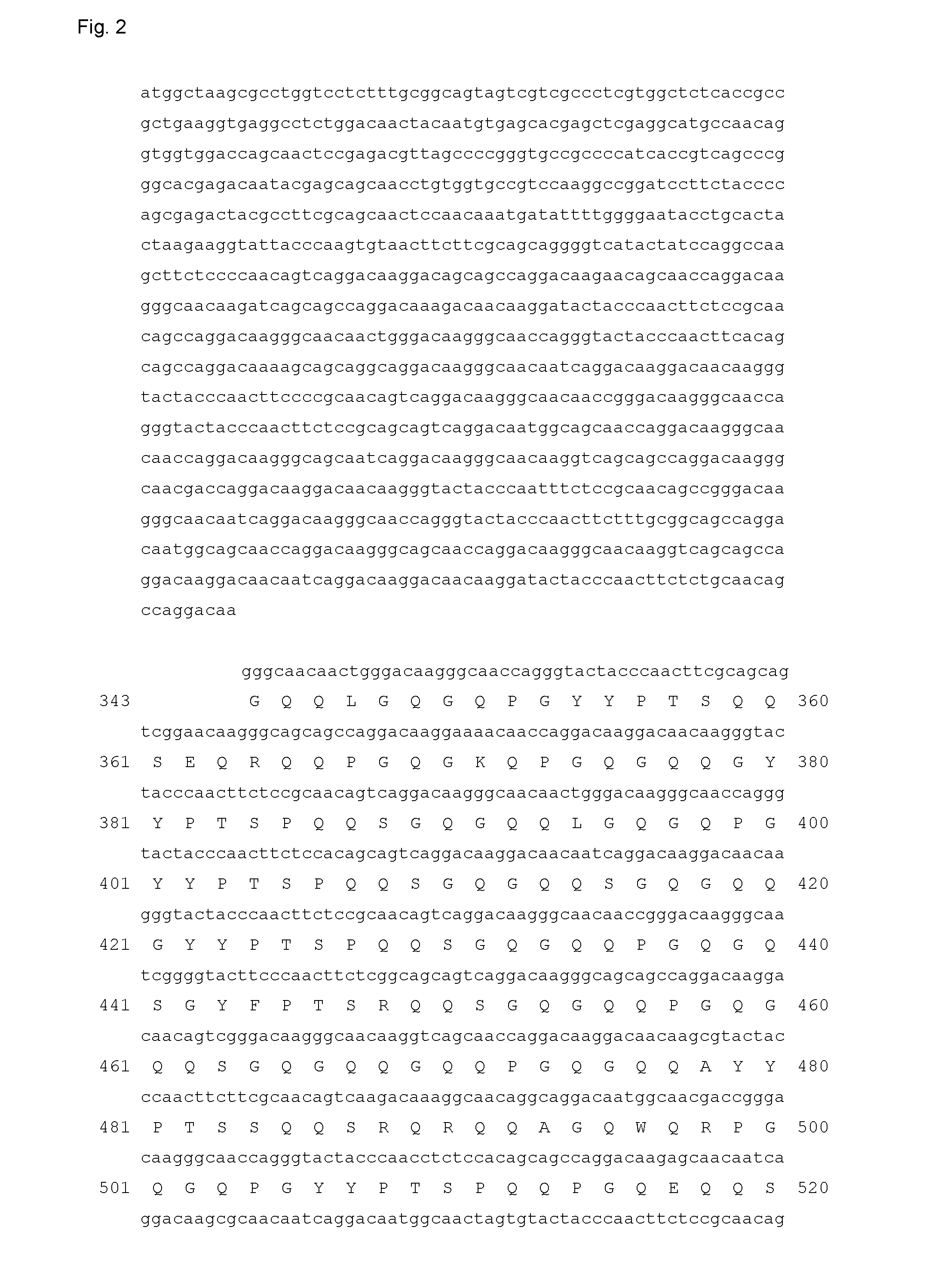Wheat Antigens and Peptides for Diagnosis of Wheat Induced Hypersensitivity
a technology of antigens and peptides, which is applied in the field of forms of wheat hypersensitivities, can solve the problems of incomplete panel of allergens, lack of defined proteins and peptides to be used as diagnostics,
- Summary
- Abstract
- Description
- Claims
- Application Information
AI Technical Summary
Benefits of technology
Problems solved by technology
Method used
Image
Examples
example 1
Construction and Screening of a λgt11 cDNA Library From Wheat Seeds
[0062]In order to find new wheat allergens, total RNA from wheat seeds were extracted and a λgt11 cDNA library was constructed as described previously (5). E. coli Y1090 were infected with 7×105 PFU of recombinant phages and immunoscreened with serum IgE of three patients suffering from wheat food allergy. After pre-adsorption with nitrocellulose filters, containing λgt11 phages, the 1:10 serum dilution was added to the filters prepared from the already titrated phage clones. Bound IgE antibodies were detected with 1:10 diluted 125I-labeled α-human IgE and visualized by autoradiography. The IgE-reactive phage clones were selected for further re-cloning and their DNA was PCR-amplified using Platinum PCR SuperMix (Invitrogen) with λgt11 primers and sequenced (VBC-Biotech). The obtained sequences were compared with sequences submitted to the GenBank database at the National Center for Biotechnology Information (NCBI) to...
example 2
Expression and Purification
Clone 175 and Glub3-23
[0063]The clone 175 sequence (SEQ ID NO: 1) containing 537 nucleotides and the corresponding full sequence GluB3-23 (SEQ ID NO: 51) involving 1107 nucleotides and six His codons were cloned into pET17b E. coli expression vectors. The pET 17b-C175 and the pET 17b-GluB3-23 construct were transformed into E. coli BL21 (DE3). The transformed cells were grown in 1 liter Luria Broth medium containing 100 mg / l ampicillin at 37° C. The cells were grown until an OD600 of 0.4-0.6, and then the over expression was induced by addition of isopropyl β-D-thiogalactopyranoside (IPTG) to a final concentration of 0.5 mM. Afterwards the bacteria were grown for 4 additional hours; cells were harvested by centrifugation and frozen over night at −20° C. A cleared cell lysate was prepared and a NiNTA-chromatography was performed according to QIAexpressionist handbook (QIAGEN, Hilden, Germany). The protein containing fractions were pooled and dialysed again...
example 3
Characterization of the Recombinant Proteins
C175 and GluB3-23
[0066]Sequence analysis showed that GluB3-23 is an s-LMW glutenin that contains eight cysteine residues for building intramolecular disulphide bonds for stability and intermolecular disulphide bonds with other LMW and BMW glutenin subunits to form macropolymers. The natural protein consists of a signal peptide, an N-terminal region, a repetitive domain and three C-terminal regions. The recombinant C175 protein is comprised by the three C-terminal regions and the hexa-histidine tag (FIG. 1). The recombinant Glub3-23 contains all regions of the natural Glub3-23 without the signal peptide and plus a hexa-histidine-tag (FIG. 7a).
[0067]For the recombinant C175 protein a molecular weight of 20.8 kDa and a theoretical pI of 8.81 was calculated and for the recombinant GluB3-23 a molecular weight was assessed at 40.33 kDa and the theoretical pI at 8.73. The purity and molecular mass was controlled by SDS-PAGE and Coomassie Brillia...
PUM
| Property | Measurement | Unit |
|---|---|---|
| optical density | aaaaa | aaaaa |
| mass | aaaaa | aaaaa |
| mass | aaaaa | aaaaa |
Abstract
Description
Claims
Application Information
 Login to View More
Login to View More - R&D
- Intellectual Property
- Life Sciences
- Materials
- Tech Scout
- Unparalleled Data Quality
- Higher Quality Content
- 60% Fewer Hallucinations
Browse by: Latest US Patents, China's latest patents, Technical Efficacy Thesaurus, Application Domain, Technology Topic, Popular Technical Reports.
© 2025 PatSnap. All rights reserved.Legal|Privacy policy|Modern Slavery Act Transparency Statement|Sitemap|About US| Contact US: help@patsnap.com



